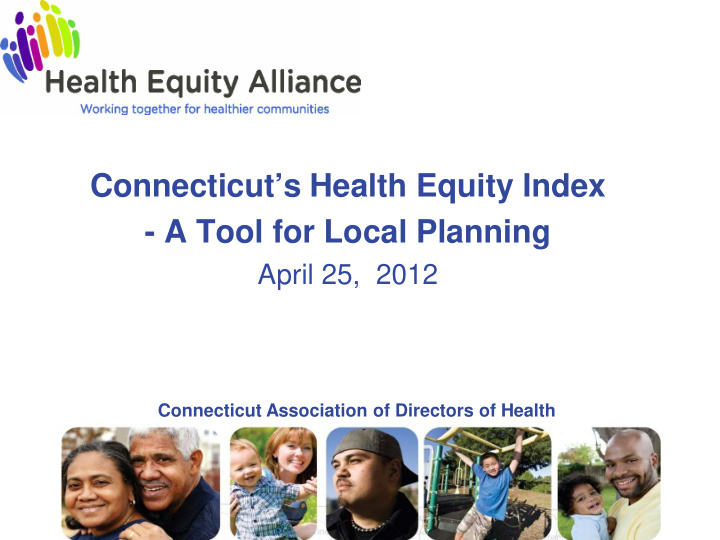



Connecticut’s Health Equity Index - A Tool for Local Planning April 25, 2012 Connecticut Association of Directors of Health
Conceptual Foundation LHD PREVENTION- ACA, CTG, NPS, NPA IOM “Assure Conditions”, selection of measures CDC/PHAB Essential P.H. Services NACCHO HP 2020 Eliminate Disparities, SDOH, Multi-sector
The Public Health System Police Home Community EMS Faith orgs Health MCOs Centers Health Department HOUSING Parks Schools Elected Hospitals Mass Transit Doctors Officials Nursing Philanthropist Homes Environmental Civic Groups Health CHCs Fire Tribal Health Economic Laboratory Employers Drug Mental Development Facilities Treatment Health
Health Equity • Asserts everyone should have a fair opportunity to attain their full health potential, and no one should be at a disadvantage. • Creates equal opportunities for good or improved health, and minimizes avoidable health disparities. Reference: Health Equity Glossary, CADH 2010 Whitehead, M., The Concepts and principles of equity and health, International Journal of Health Services, 1992; 22: 429-445.
Social Determinants of Health The circumstances in which people are born, grow up, live, work, and age, as well as the systems put in place to deal with illness. These circumstances are in turn shaped by a wider set of forces: economics, social policies, and politics. Source: Centers for Disease Control and Prevention (CDC)
Building Community Capacity Focus groups were organized by social determinant category. Land use and housing Environment Public safety Economic development Education 2 Unson, Tyson, Funaiole. Agaba; J of Health Disparities Research & Practice; Vol 4, #1, summer 2010, pp 53-69
Our Objectives Create a measurement tool that: • Focuses on social determinants of health • Builds on an analytic foundation • Expresses results as a single measure , but permits more sophisticated disaggregation and analysis • Provides comparability across a wide range of communities • Depicts the relationship between inequities and health outcomes at the local level • Serves as a platform meant to encourage debate, dialogue, and action at community level • Can be used for policy-making and changes in practices
Social Determinants of Health Civic Involvement Community Safety Economic Security Education Employment Housing Environmental Quality
Housing Indicators 1. Crowded housing as a percent of total households 2. Median gross rent as percent of household income 3. Number of subsidized housing units per 1000 local residents 4. Owner-occupied housing as a percentage of total housing units 5. Percent of households paying over 30% of income for mortgages 6. Percent of households paying over 30% of income for rent 7. Percent of households that have moved in the last 5 years 8. Rental vacancy rates as a percentage of rental units
Health Outcomes Infectious Disease Perinatal Care Childhood Illness Accidents/Violence Renal Disease Diabetes Mental Health Cardiovascular Health Care Access Respiratory Illness Liver Disease Cancer Life Expectancy
Structure of the Health Equity Index • Each Determinant is comprised of a number of Indicators . • Indicators are measures that have been identified, and collected on a statewide basis. • A Statewide Reference Point that is based upon the Connecticut median for each indicator. • From the reference point, cities, towns, and neighborhoods are assigned scores (from 1 to 10) for each indicator. • For each determinant and health outcome, the Health Equity Index generates an average score for every city, town, and neighborhood.
Town Scores
Compare Towns
Scores on the Town Summary Page • Indicators • Health Outcome Indicators • Determinants • Index
Side-by-Side Mapping
Correlation
The Health Equity Index can be used to: • Assess health impacts of development • Inform town plans of conservation and development • Inform zoning and ordinance revisions to promote health • Support housing and transportation initiatives that create more affordable housing in neighborhoods of opportunity
LHDs Have Used the Health Equity Index to: • Write grants and secure funding awards • Assess community health needs • Sharpen their focus in strategic planning and decision-making • Foster collaboration with community organizations and municipal leaders • Promote workforce development and enhance employee skill levels
Questions?
Recommend
More recommend